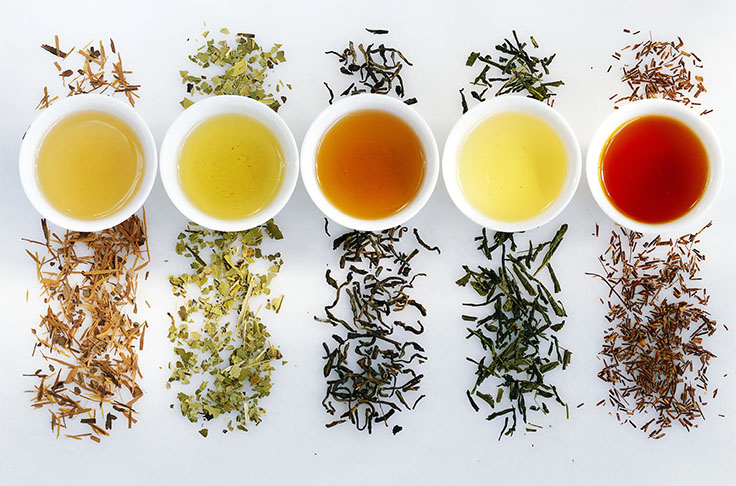Teas are subdivided into many varieties and species on various grounds. It is quite easy to understand in all the variety.
- Chinese variety – this includes Chinese, Japanese teas, Darjeeling, Formosa, Vietnamese, Georgian teas.
- Assam variety – it includes Indian, Ceylon, African and other teas.
- Cambodian variety – a hybrid of Assamese and Chinese varieties grown in some parts of Indochina.
- Green tea;
- Black tea;
- White tea;
- Oolong tea (red tea, oolong, oolong);
- Puer (Pu-er) tea.
There are many ways to process tea, including withering, drying, twisting, fermentation, etc.
Depending on these, many teas are produced, with names most often associated with color.
Green teas – rich in vitamins and nutrients, high in caffeine. They have a dim infusion of yellowish to green color, with a bright aroma and rich flavor.
Black tea is the most fermented tea. It undergoes the maximum number of operations before it goes on sale. Very popular in Russia (in China black tea is called red tea).
White tea – produced from tender half-ripened leaves. Can be attributed to the rarest and most expensive teas, in addition, it is very sensitive to transportation and storage. The production process involves only wilting and drying. Brewing different varieties of white tea results in a drink with a floral aroma and a surprisingly pleasant taste. White tea has no equal among other teas in terms of healing properties.
Yellow teas are close to green teas in their characteristics. They are produced only in the Chinese province of Fujian.
Oolong teas (oolongs) by the degree of fermentation are between green and black tea. In our country, this type of tea is also called red tea. They have a unique flavor, which brought them popularity.
Puer is a pressed tea made by a special technology from green tea. Usually puerh teas come in various pressed forms – bars, bricks, tortillas, etc.
- Indian tea;
- Chinese tea;
- Ceylon tea;
- Japanese tea;
- Tea-like beverages;
- Herbal tea.
Just a few countries grow most of the world’s tea.
The home of tea, China, supplies the world market with more than a quarter of the total. It produces both black and green teas, which are popular all over the world, and puerh and oolong teas, as well as white and yellow teas, which are made only in the Celestial Empire.
The second place in production is occupied by India, which mostly produces black teas, mainly cut and granulated teas. The volume of green tea production in the country is not very large. India also produces elite Darjeeling tea grown on highland plantations.
Ceylon (Sri Lanka) grows about 10% of the world’s tea. Ceylon teas are similar to Indian teas in many ways.
Japan produces exclusively green tea, mostly for its own consumption – only some popular varieties are exported.
The largest supplier of African tea is Kenya.
Teas are also grown in Uganda, Cameroon, Zimbabwe, South Africa, and other former British colonies.
Tea began to be produced here by English colonists in the XIX century, bringing it from India.
Only black teas are produced in Africa.
- High-grade whole leaf teas;
- Medium grade teas;
- Low-grade ground teas;
- Decoding of abbreviations;
- Fermentation;
- Non-fermented tea is white and greentea;
- Semi-fermented are yellow, red (oolong), and blue (purple) teas;
- Fermented tea is blacktea;
- Smoking;
- Roasting.
- With aromatic additives and essential oils;
- With the addition of dried berries and fruits (fruit teas);
- Various mixtures and variations with the addition of flowers and herbs.
Various essential oils, fruits and berries are used for additives.
Tea with bergamot, jasmine is popular, lotus and rose flowers, orange and cherry can also be used, as well as various artificial additives.
These do not contain tea leaves, although they are traditionally called teas or phyto teas; they may include:
- Chamomile;
- Currant;
- Rosehip;
- St. John’s wort;
- Thyme;
- Oregano;
- Peppermint;
- Cudine;
- Karkade;
- Honeybush;
- Mate;
- Rooibos (rooibos).
Herbal teas are not only enjoyable but also healthy beverages, each of which can be used both for drinking and for treating a variety of ailments.
Carcade tea is made from hibiscus and has many healing properties, for which it is called “the cure for all diseases” in Arab culture. It is consumed cold and hot.
Maté tea is a popular variety of phyto-tea from Latin America, which is made from the Paraguayan holly. It is drunk from a special calebasa using a bombilla tube.
Rooibos tea is a type of African tea produced from the plant of the same name. It is a pleasant and healthy drink, beneficial to health, caffeine-free and high in antioxidants.

